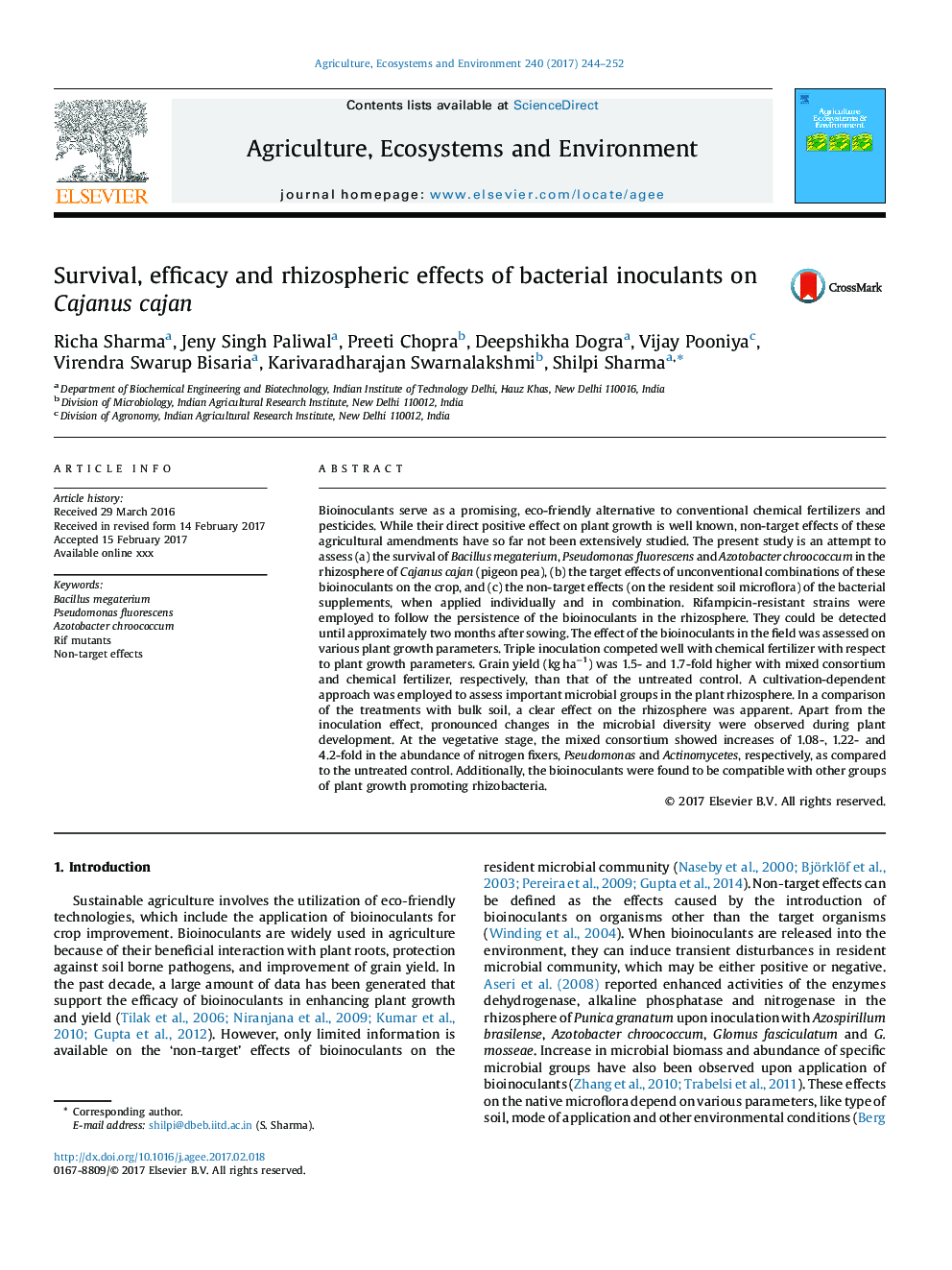| کد مقاله | کد نشریه | سال انتشار | مقاله انگلیسی | نسخه تمام متن |
|---|---|---|---|---|
| 5538172 | 1552012 | 2017 | 9 صفحه PDF | دانلود رایگان |
عنوان انگلیسی مقاله ISI
Survival, efficacy and rhizospheric effects of bacterial inoculants on Cajanus cajan
دانلود مقاله + سفارش ترجمه
دانلود مقاله ISI انگلیسی
رایگان برای ایرانیان
کلمات کلیدی
موضوعات مرتبط
علوم زیستی و بیوفناوری
علوم کشاورزی و بیولوژیک
علوم زراعت و اصلاح نباتات
پیش نمایش صفحه اول مقاله

چکیده انگلیسی
Bioinoculants serve as a promising, eco-friendly alternative to conventional chemical fertilizers and pesticides. While their direct positive effect on plant growth is well known, non-target effects of these agricultural amendments have so far not been extensively studied. The present study is an attempt to assess (a) the survival of Bacillus megaterium, Pseudomonas fluorescens and Azotobacter chroococcum in the rhizosphere of Cajanus cajan (pigeon pea), (b) the target effects of unconventional combinations of these bioinoculants on the crop, and (c) the non-target effects (on the resident soil microflora) of the bacterial supplements, when applied individually and in combination. Rifampicin-resistant strains were employed to follow the persistence of the bioinoculants in the rhizosphere. They could be detected until approximately two months after sowing. The effect of the bioinoculants in the field was assessed on various plant growth parameters. Triple inoculation competed well with chemical fertilizer with respect to plant growth parameters. Grain yield (kg haâ1) was 1.5- and 1.7-fold higher with mixed consortium and chemical fertilizer, respectively, than that of the untreated control. A cultivation-dependent approach was employed to assess important microbial groups in the plant rhizosphere. In a comparison of the treatments with bulk soil, a clear effect on the rhizosphere was apparent. Apart from the inoculation effect, pronounced changes in the microbial diversity were observed during plant development. At the vegetative stage, the mixed consortium showed increases of 1.08-, 1.22- and 4.2-fold in the abundance of nitrogen fixers, Pseudomonas and Actinomycetes, respectively, as compared to the untreated control. Additionally, the bioinoculants were found to be compatible with other groups of plant growth promoting rhizobacteria.
ناشر
Database: Elsevier - ScienceDirect (ساینس دایرکت)
Journal: Agriculture, Ecosystems & Environment - Volume 240, 1 March 2017, Pages 244-252
Journal: Agriculture, Ecosystems & Environment - Volume 240, 1 March 2017, Pages 244-252
نویسندگان
Richa Sharma, Jeny Singh Paliwal, Preeti Chopra, Deepshikha Dogra, Vijay Pooniya, Virendra Swarup Bisaria, Karivaradharajan Swarnalakshmi, Shilpi Sharma,